The Former Crown Prince’s Palace, now known as the Akasaka Palace (Geihinkan), was built in the Meiji era as a symbol of Japan’s national prestige. It is a Western-style palace of remarkable grandeur, designated as a National Treasure for its architectural and historical value.
History of the Former Crown Prince’s Palace
The palace was completed in 1909. At the time, Japan was embracing Western culture and striving to establish itself as a modern nation. The construction of this palace was one of the most symbolic projects of that era. Although it was originally intended as the residence of the Crown Prince, it was rarely used as such and its role shifted over time.
After World War II, it became Japan’s official guesthouse, welcoming foreign dignitaries. In 1974, it was opened to the public as the Akasaka Palace, and in 2009, it was formally designated as a National Treasure, recognized as a masterpiece of modern Western architecture in Japan.
| Period | Event |
|---|---|
| 1909 | Completed as the residence of the Crown Prince |
| Post-WWII | Converted into Japan’s official guesthouse |
| 1974 | Opened to the public as the Akasaka Palace |
| 2009 | Designated as a National Treasure |
Architectural Style and Features
The Former Crown Prince’s Palace is a palace built in the French Neo-Renaissance style. Its exterior is made of white granite, with a perfectly symmetrical design. The central dome and the extended wings showcase the grandeur typical of European palatial architecture.
Inside, visitors are greeted by a grand marble staircase, enormous chandeliers, and walls adorned with detailed frescoes and sculptures. The ceilings and walls are decorated with motifs from European mythology and history, creating an opulent and dignified atmosphere.
At the same time, subtle elements of Japanese aesthetics are incorporated, blending Western elegance with a uniquely Japanese sense of harmony. The palace also demonstrates the highest level of craftsmanship of its time, with exquisite furnishings and decorations, adding artistic value beyond its architectural merit.
| Element | Feature |
|---|---|
| Exterior | White granite, symmetrical layout |
| Interior | Marble staircase, chandeliers, frescoes |
| Style | French Neo-Renaissance |
| Character | Fusion of Western elegance and Japanese aesthetics |
Role in the Modern Era
Today, the Akasaka Palace serves as Japan’s official state guesthouse, used to host kings, presidents, and prime ministers from around the world. It plays a crucial role in international diplomacy, serving as a venue for official banquets, high-level talks, and international conferences.
The hospitality provided here is more than ceremonial. Through banquets featuring Japanese cuisine, traditional tea ceremonies, and performances of Noh theater, the palace also functions as a cultural showcase, presenting Japan’s heritage to the world.
| Occasion | Function |
|---|---|
| International talks | Bilateral summits and multilateral meetings |
| Banquets | Formal state dinners for dignitaries |
| Cultural exchange | Tea ceremony, traditional performing arts |
| Accommodation | Lodging for kings, presidents, and prime ministers |
Appeal as a Tourist Destination
The Akasaka Palace is also a National Treasure open to the public, attracting both domestic and international visitors. Guided tours allow guests to walk through lavish halls and reception rooms, experiencing firsthand the grandeur that photographs cannot fully capture.
The palace grounds also feature a beautiful garden, where nature and architecture coexist in harmony. Each season offers a unique experience: cherry blossoms in spring, lush greenery in summer, brilliant autumn foliage, and snow-covered serenity in winter.
| Season | Highlights |
|---|---|
| Spring | Cherry blossoms contrasting with the palace |
| Summer | Lush gardens and fountains |
| Autumn | Harmony of autumn leaves and the palace |
| Winter | Snow-covered majestic facade |
To accommodate international tourists, multilingual guides and explanations are available in English, Chinese, French, and other languages, making the palace accessible to a global audience.
Conclusion
The Former Crown Prince’s Palace, now the Akasaka Palace, is a symbol of Japan’s modernization. Its magnificent exterior and interior represent the peak of Western architecture, while still incorporating elements of Japanese aesthetics.
Today, it remains at the forefront of diplomacy while also serving as a cultural and historical landmark open to the public. Visiting the Akasaka Palace allows one to experience both Japan’s modern history and its role in global diplomacy in one setting.
The Akasaka Palace is not only a cultural bridge between past and present but also a National Treasure that must be preserved for the future.






